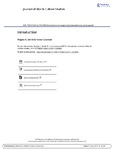Introduction
| dc.contributor.author | Smith, Angela | |
| dc.contributor.author | Cowman, K | |
| dc.date.accessioned | 2018-01-16T11:16:22Z | |
| dc.date.available | 2018-01-16T11:16:22Z | |
| dc.date.issued | 2017-05-09 | |
| dc.identifier.issn | 1752-6272 | |
| dc.identifier.issn | 1752-6280 | |
| dc.identifier.uri | http://hdl.handle.net/10026.1/10585 | |
| dc.description.abstract |
One hundred years after the outbreak, historians and media commentators alike agree that the First World War occupies an almost unique place in cultural memory. Shared ways of remembering the conflict continue to develop even as those who had personal experience of the war have died. But whereas traditionally, historiographical focus has rested on the Western Front, more recently scholars have begun to consider the real global repercussions of the war. Although the direct protagonists were the great powers of Europe, their involvement had the effect of pulling many other nations towards the conflict. In the century and half before 1914, European powers had competed to develop empires that covered the world. These colonies included many conquered nations, in Africa, India, and the Far East as well as British Dominions, Australia, New Zealand, South Africa, and Canada. All these nations were called upon to ‘do their bit’ to send troops and medical support around the world to sites of conflict in Europe and the Middle East. Always subordinate to the combat soldier of the Western Front, these soldiers, nurses, and civilians present multiple alternative stories of the war that need to be explored. | |
| dc.format.extent | 193-197 | |
| dc.language | en | |
| dc.language.iso | en | |
| dc.publisher | Taylor & Francis | |
| dc.title | Introduction | |
| dc.type | journal-article | |
| dc.type | Editorial | |
| dc.type | Journal | |
| plymouth.author-url | https://www.webofscience.com/api/gateway?GWVersion=2&SrcApp=PARTNER_APP&SrcAuth=LinksAMR&KeyUT=WOS:000367449700001&DestLinkType=FullRecord&DestApp=ALL_WOS&UsrCustomerID=11bb513d99f797142bcfeffcc58ea008 | |
| plymouth.issue | 3 | |
| plymouth.volume | 10 | |
| plymouth.publication-status | Published | |
| plymouth.journal | Journal of War and Culture Studies | |
| dc.identifier.doi | 10.1080/17526272.2017.1320852 | |
| plymouth.organisational-group | /Plymouth | |
| plymouth.organisational-group | /Plymouth/Faculty of Arts, Humanities and Business | |
| plymouth.organisational-group | /Plymouth/Faculty of Arts, Humanities and Business/School of Society and Culture | |
| plymouth.organisational-group | /Plymouth/REF 2021 Researchers by UoA | |
| plymouth.organisational-group | /Plymouth/REF 2021 Researchers by UoA/UoA27 English Language and Literature | |
| plymouth.organisational-group | /Plymouth/Users by role | |
| plymouth.organisational-group | /Plymouth/Users by role/Academics | |
| dcterms.dateAccepted | 2017-01-01 | |
| dc.rights.embargodate | 2018-11-9 | |
| dc.identifier.eissn | 1752-6280 | |
| dc.rights.embargoperiod | Not known | |
| rioxxterms.versionofrecord | 10.1080/17526272.2017.1320852 | |
| rioxxterms.licenseref.uri | http://www.rioxx.net/licenses/all-rights-reserved | |
| rioxxterms.licenseref.startdate | 2017-05-09 | |
| rioxxterms.type | Journal Article/Review |


